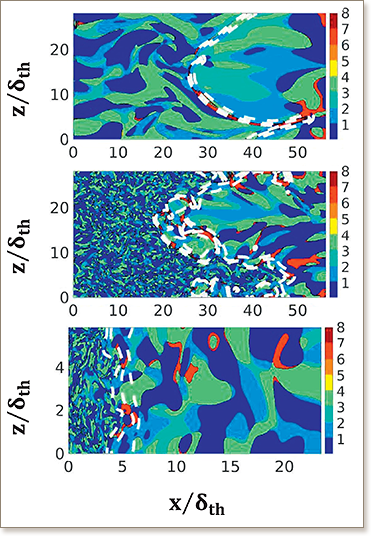

Scalar dissipation rate transport conditional on flow topologies in different regimes of premixed turbulent combustion
N. Chakraborty, D.H. Wacks, S. Ketterl, M. Klein, H.G. Im
Proceedings of the Combustion Institute, 37 (2), pp. 2353-2361, (2019)

The Favre-averaged scalar dissipation rate transport conditional on local flow topologies in premixed turbulent flames has been analysed based on a detailed chemistry Direct Numerical Simulation database of statistically planar turbulent hydrogen-air premixed flames with an equivalence ratio of 0.7 representing the corrugated flamelets, thin reaction zones and broken reaction zones regimes of premixed turbulent combustion. The local flow topologies have been categorised by the values of the three invariants of the velocity gradient tensor and the statistical behaviour of the Favre-averaged scalar dissipation rate conditional on these flow topologies has been analysed in detail for different choices of reaction progress variable. The qualitative behaviour of the scalar-turbulence interaction term in the Favre-averaged scalar dissipation rate transport equation has been found to be affected by the regime of combustion, whereas the chemical reaction rate gradient contribution to the scalar dissipation rate transport has been found to be affected by the choice of the reaction progress variable. The topologies, which exist for all values of dilatation rate, contribute significantly to the Favre-averaged scalar dissipation rate transport in premixed turbulent flames for all regimes of combustion. In addition, the flow topologies, which are obtained only for positive values of dilatation rate, contribute significantly to the Favre-averaged scalar dissipation rate transport in the case representing the corrugated flamelets regime combustion. An unstable nodal flow topology, which is representative of a counter-flow configuration, has been found to be a dominant contributor to the Favre-averaged scalar dissipation rate transport for all regimes of combustion irrespective of the choice of reaction progress variable.